Messier 81 (also known as NGC 3031 or Bode’s Galaxy) is a grand design spiral galaxy about 12 million light-years away, with a diameter of 90,000 light years, in the constellation Ursa Major. Due to its proximity to our galaxy, large size, and active galactic nucleus (which harbors a 70 million M☉ supermassive black hole), Messier 81 has been studied extensively by professional astronomers.
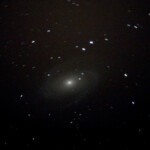
M81. Bodes galaxy
An early attempt to capture M81 with the CPC 925 reflector and the Nikon D800 camera in Åva, March 2015.
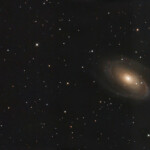
M82, Cigar Galaxy, and M81, Bode’s galaxy
Mosaic of two images taken with the RC8″ reflector telescope and the ASI 2600MC CMOS color camera in Åva, February 2024. Exposure was 57 minutes for the left image and 96 minutes for the right image, both with IDAS LPS P3 light pollution filter. Mosaic made by Pixinsight gradient tool.

M82, Cigar Galaxy, and M81, Bode’s galaxy
Mosaic of two images taken with the RC8″ reflector telescope and the ASI 2600MC CMOS color camera in Åva, February 2024. Exposure was 57 minutes for the left image and 96 minutes for the right image, both with IDAS LPS P3 light pollution filter. Mosaic made by Pixinsight gradient tool.
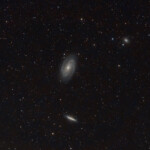
M81. Bodes galaxy
M81, Bodes galaxy photographed with APO107 refractor and Nikon D800 camera in Åva, March 2018. 17 exposures of 2 min each.
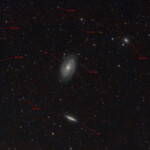
M81. Bodes galaxy
M81, Bodes galaxy photographed with APO107 refractor and Nikon D800 camera in Åva, March 2018. 17 exposures of 2 min each.
![Messier 81 (also known as NGC 3031 or Bode's Galaxy) is a grand design spiral galaxy about 12 million light-years away, with a diameter of 90,000 light years, about half the size of the Milky Way, in the constellation Ursa Major. It has an active galactic nucleus which harbors a 70 million sun masses] supermassive black hole).
Messier 82 (also known as NGC 3034, Cigar Galaxy or M82) is a starburst galaxy approximately 12 million light-years away in the constellation Ursa Major. A member of the M81 Group, it is about five times more luminous than the whole Milky Way and has a center one hundred times more luminous than our galaxy's center.] The starburst activity is thought to have been triggered by interaction with neighboring galaxy M81. As the closest starburst galaxy to Earth, M82 is the prototypical example of this galaxy type.
Photographed with APO107 refractor and Atik 460EX monochrome CCD camera in Stuvsta, January 2020. Exposure 10 min each RGB channel, HA 76min, and OIII 52min. M81. Bodes galaxy](https://astro.hal1.se/wp-content/uploads/cache/2023/03/m81_haoiiirgb_158min_ps/3202994963.jpg)
M81. Bodes galaxy
Messier 81 (also known as NGC 3031 or Bode’s Galaxy) is a grand design spiral galaxy about 12 million light-years away, with a diameter of 90,000 light years, about half the size of the Milky Way, in the constellation Ursa Major. It has an active galactic nucleus which harbors a 70 million sun masses] supermassive black hole).
Messier 82 (also known as NGC 3034, Cigar Galaxy or M82) is a starburst galaxy approximately 12 million light-years away in the constellation Ursa Major. A member of the M81 Group, it is about five times more luminous than the whole Milky Way and has a center one hundred times more luminous than our galaxy’s center.] The starburst activity is thought to have been triggered by interaction with neighboring galaxy M81. As the closest starburst galaxy to Earth, M82 is the prototypical example of this galaxy type.
Photographed with APO107 refractor and Atik 460EX monochrome CCD camera in Stuvsta, January 2020. Exposure 10 min each RGB channel, HA 76min, and OIII 52min.

M81 (Bodes galaxy) and M82
Messier 81 (also known as NGC 3031 or Bode’s Galaxy) is a grand design spiral galaxy about 12 million light-years away, with a diameter of 90,000 light years, in the constellation Ursa Major. Due to its proximity to our galaxy, large size, and active galactic nucleus (which harbors a 70 million M☉ supermassive black hole), Messier 81 has been studied extensively by professional astronomers.
Messier 82 (also known as NGC 3034, Cigar Galaxy or M82) is a starburst galaxy approximately 12 million light-years away in the constellation Ursa Major. A member of the M81 Group, it is about five times more luminous than the Milky Way and has a center one hundred times more luminous. The starburst activity is thought to have been triggered by interaction with neighboring galaxy M81. As the closest starburst galaxy to Earth, M82 is the prototypical example of this galaxy type. n 2014, in studying M82, scientists discovered the brightest pulsar yet known, designated M82 X-2.
Photographed with APO107 refractor telescope and ASI 2600MC color camera in Stuvsta, October 2021. Exposure was 30*3min with IDAS LPS D2 light pollution filter.
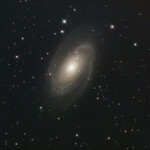
M81, Bode’s Galaxy
Messier 81 (also known as NGC 3031 or Bode’s Galaxy) is a grand design spiral galaxy about 12 million light-years away in the constellation Ursa Major. It has a D25 isophotal diameter of 29.44 kiloparsecs (96,000 light-years). Because of its relative proximity to the Milky Way galaxy, large size, and active galactic nucleus (which harbors a 70 million M☉ supermassive black hole), Messier 81 has been studied extensively by professional astronomers. In late February 2022, astronomers reported that M81 may be the source of FRB 20200120E, a repeating fast radio burst.
Messier 81 is the largest galaxy in the M81 Group, a group of 34 in the constellation Ursa Major. At approximately 11.7 Mly (3.6 Mpc) from the Earth, it makes this group and the Local Group, containing the Milky Way, relative neighbors in the Virgo Supercluster.
Photographed with the RC8″ reflector telescope and the ASI 2600MC CMOS color camera in Åva, February 2024. Exposure was 96 minutes in bright moonshine, using IDAS LPS P3 light pollution filter.

M81, Bode’s Galaxy
Messier 81 (also known as NGC 3031 or Bode’s Galaxy) is a grand design spiral galaxy about 12 million light-years away in the constellation Ursa Major. It has a D25 isophotal diameter of 29.44 kiloparsecs (96,000 light-years). Because of its relative proximity to the Milky Way galaxy, large size, and active galactic nucleus (which harbors a 70 million M☉ supermassive black hole), Messier 81 has been studied extensively by professional astronomers. In late February 2022, astronomers reported that M81 may be the source of FRB 20200120E, a repeating fast radio burst.
Messier 81 is the largest galaxy in the M81 Group, a group of 34 in the constellation Ursa Major. At approximately 11.7 Mly (3.6 Mpc) from the Earth, it makes this group and the Local Group, containing the Milky Way, relative neighbors in the Virgo Supercluster.
Photographed with the RC8″ reflector telescope and the ASI 2600MC CMOS color camera in Åva, February 2024. Exposure was 96 minutes in bright moonshine, using IDAS LPS P3 light pollution filter.

M81 (Bodes galaxy) and M82
Messier 81 (also known as NGC 3031 or Bode’s Galaxy) is a grand design spiral galaxy about 12 million light-years away, with a diameter of 90,000 light years, in the constellation Ursa Major. Due to its proximity to our galaxy, large size, and active galactic nucleus (which harbors a 70 million M☉ supermassive black hole), Messier 81 has been studied extensively by professional astronomers.
Messier 82 (also known as NGC 3034, Cigar Galaxy or M82) is a starburst galaxy approximately 12 million light-years away in the constellation Ursa Major. A member of the M81 Group, it is about five times more luminous than the Milky Way and has a center one hundred times more luminous. The starburst activity is thought to have been triggered by interaction with neighboring galaxy M81. As the closest starburst galaxy to Earth, M82 is the prototypical example of this galaxy type. n 2014, in studying M82, scientists discovered the brightest pulsar yet known, designated M82 X-2.
Photographed with APO107 refractor telescope and ASI 2600MC color camera in Stuvsta, October 2021. Exposure was 30*3min with IDAS LPS D2 light pollution filter.

M81 (Bodes galaxy) and M82
Messier 81 (also known as NGC 3031 or Bode’s Galaxy) is a grand design spiral galaxy about 12 million light-years away, with a diameter of 90,000 light years, in the constellation Ursa Major. Due to its proximity to our galaxy, large size, and active galactic nucleus (which harbors a 70 million M☉ supermassive black hole), Messier 81 has been studied extensively by professional astronomers.
Messier 82 (also known as NGC 3034, Cigar Galaxy or M82) is a starburst galaxy approximately 12 million light-years away in the constellation Ursa Major. A member of the M81 Group, it is about five times more luminous than the Milky Way and has a center one hundred times more luminous. The starburst activity is thought to have been triggered by interaction with neighboring galaxy M81. As the closest starburst galaxy to Earth, M82 is the prototypical example of this galaxy type. n 2014, in studying M82, scientists discovered the brightest pulsar yet known, designated M82 X-2.
Photographed with MN190 reflector telescope and ASI 2600MC color camera in Stuvsta, March 2022. Exposure was 27*3min with IDAS LPS P3 light pollution filter.